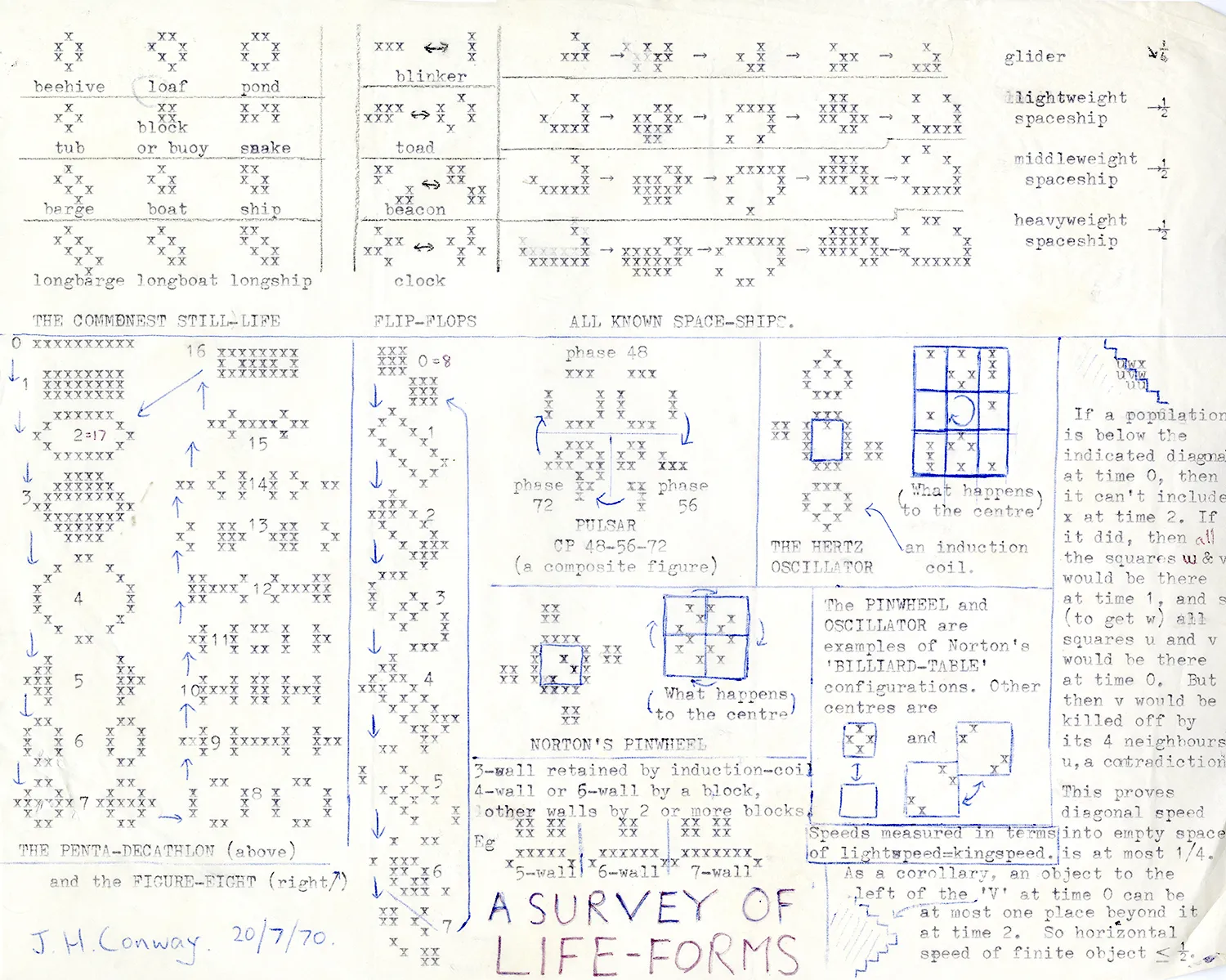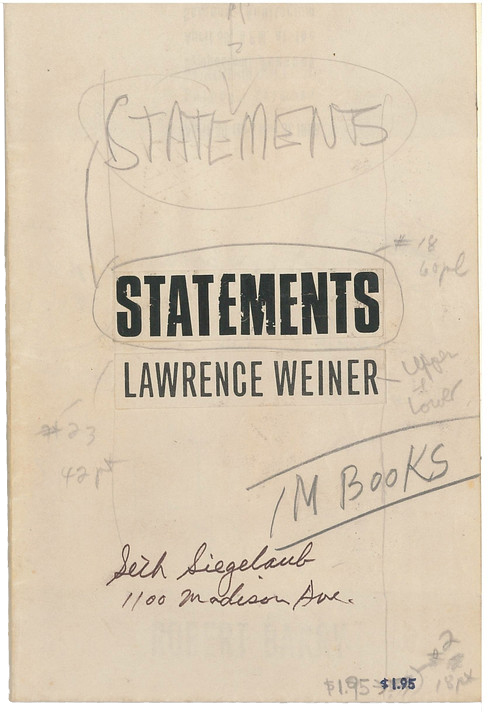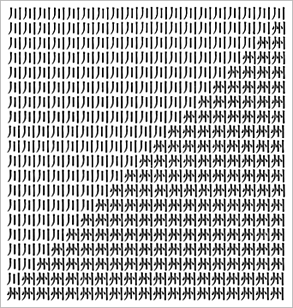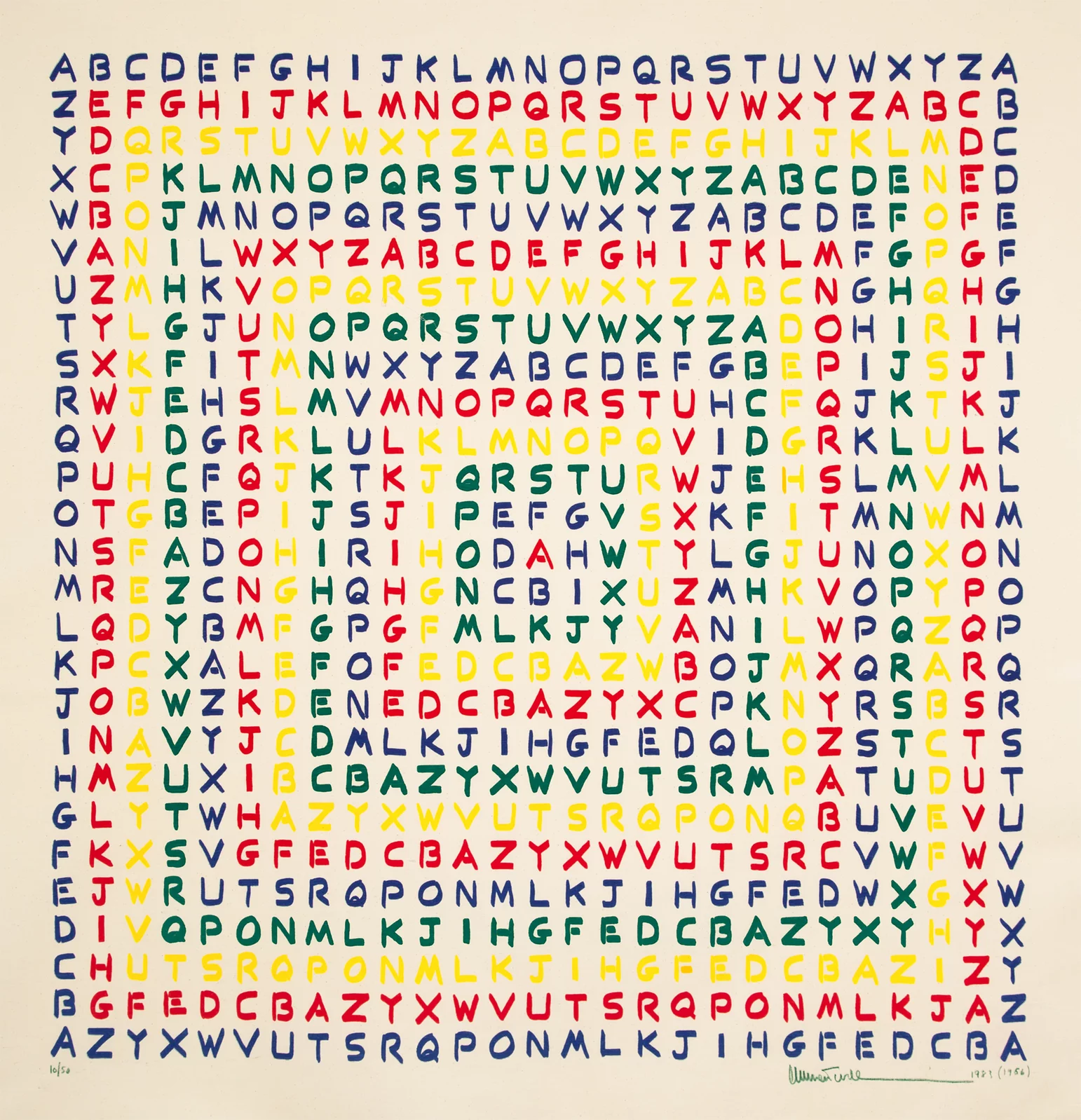Anipoem for January 26, 2024 (Today)
Prompt
Using the Game of Life as the framework, create an “anipoem” for today (January 26, 2024). To do this, download this zip file, and open it in Sublime Text. You will edit the .js file to create the conditions for your poem, then draw on the HTML “canvas” to create its form (more on this later).
Requirements
- Demo code file
- Code editor (Sublime Text recommended)
- Paper
- Pencil

Anipoems
The term Anipoem is most commonly associated with the work of artist Ana Maria Uribe. In the 1960s she began creating Typoems – Concrete Poetry works written with Lettera 22 and Pica type typewriters. In 1997 she created the Anipoems, moving concrete poems hosted on the web which continued the ideas present in her Typoems. These poems exhibited many recurring themes and visual formats, as summarized by Jorge Luiz Antonio in an essay commemarting Uribe’s work. He describes their themes as:
“A thematic group runs through the Typoems and Anipoems: a course by the aspects of life through words-titles and wordsimages, since the visual, sound and animation produce another syntax (it would be the digital or hypermedia syntax, the result of interacting links and languages?). Thus, we have the nature (Waterfall, Autumn, Winter, Spring, etc.), the city, the circus, the discipline, the tennis, the orchestra rehearsal, the train in motion, the busy day, episodes seemingly fragmented of our daily hlife. The look of the author creates a kind of journal by keywords. The shift from printed to electronic communication. Uribe would certainly write object-poems in the third dimension, poemssculptures, maybe she would turn them into videopoems if she had not chosen the digital medium.
Her works range from the mundane – “Poema cortante / A Cutting Poem” emulates a blade cutting through a paper or which emulates the movement of a zipper. To the sublime – “Hojas Rojas Secas [Dry Red Leaves]” uses the colors of fall and a downward movement of letterforms to represent leaves dying and falling to the ground in the Fall season.
The Anipoems are evocative of other concrete poets, such as “E. M. de Melo e Castro, Jim Andrews, Augusto de Campos, Sérgio Capparelli and Ana Claudia Gruszynski, Arnaldo Antunes, David Daniels (1933-2008), Clemente Padin, among others”. However, her work is also responding to the conditions of the screen, network (internet), and time in a way that was inaccessible when many of their works were made.

The Game of Life
John Conway, an English mathematician, created the Game of Life in 1970, as part of his exploration into complex systems and cellular automata. He was interested in a problem in mathematical logic called the Turing machine, and specifically in the question of whether a very simple system could exhibit complex behavior.
The game is a demonstration of “cellular automata”, a math concept with a grid of cells that evolve over time based on predetermined conditions. This concept is used for modeling behaviors such as forest fires, traffic flow, and other systems.
In the case of the game of life, it is a “zero player” game, meaning that it plays out only with the initial input and no further interaction. The game is played on a grid of square cells, with each cell having two possible states – alive or dead. The state of each cell changes each turn based on the number of living neighbors it has. The rules are simple:
- Any live cell with fewer than two live neighbors dies (underpopulation).
- Any live cell with two or three live neighbors lives on to the next generation.
- Any live cell with more than three live neighbors dies (overpopulation).
- Any dead cell with exactly three live neighbors becomes a live cell (reproduction).
The game led to the popularization of cellular automata as a concept and has generated much study and artworks using similar concepts.
Within the game, visual forms have emerged, or been found through study, that have unique properties. For instance, an “oscillator” runs through a sequence in an infinite loop. A “glider” which travels across the canvas in a single direction. And a “still life” which never changes unless another element encroaches upon it. These forms are still being found today, as an enthusiast community continues to investigate the game.

Process
For our Animpoems, we’ll be combining ideas of Uribe’s work with the Game of Life, as a way to explore today at (salt).

Step 1
Before editing the code files, begin by thinking through what a poem “about today” can entail. Is it your everyday life? Does it memorialize the important events of today for future reflection (or describe your relationship to those events)? Does it reflect on the ephemerality of trying to capture a day in a poem?
Some things you may consider as subject matter…
- The news of today
- Today’s weather and ocean conditions (wind, sea level, air quality, etc.)
- The building of (salt), how many guests are there today? What does it look like from your favorite view of the sea or Jeju island, etc.
- Your horoscope
Also, as these are poems, consider how they may sound if they were performed audibly.
There is no expected outcome from this exercise, I think ideally it can provide some insight into your thought process, and express it in an interesting form.
Step 2
Drag index.html into the web browser. Begin experimenting with different shapes to see how they flow through the game. Try clicking the buttons [Figure Eight], [Turtle], and [Glider], and so on to quickly test some shapes. Reference The Game of Life wiki and explore different patterns and their attributes.

Step 3
Edit the script.js file to experiment with the value of const alivePhrase = "■"; (the text in between the "" marks). Type a string of characters and see how it plays out over the game to create a sequence and consider the reading experience.

To get started, try repurposing an existing poem (such as Lawrence Weiner’s Statements, or “A rose is a rose is a rose” by Gertrude Stein). Experiment with different scripts, punctuation, and unicode patterns.

Step 4
Replace the value of const deadPhrase = " "; and see how it impacts the game.

Step 5
Adjust the values of const aliveColors = [“black"] and of const deadPhrase = ["lightgrey"]. You can use any colors listed in the CSS color names list here.
One thing to note is you need as many characters in your sequence as colors in order for them to cycle (if your const aliveColors = [“black", “red"] and const alivePhrase = "A" it will only ever show black text. To show red text you would adjust your phrase like const alivePhrase = "A, B".
Draw your pattern, and write down your phrases along with any other info about your poem (color, speed, etc), on a piece of paper. Share your poems animation with the group.

Going Further: you can also try experimenting with the size of the type (by editing the array const fontSizes = ["20px"];), and the speed of the animation let updateInterval = 200; defined in milliseconds. The code also creates track of the previous state of the grid and displays it in the CSS as #previousStepCanvas if you adjust its opacity you can see its effect.
Resources
- Life Wiki
- Oscillator
- Still Life
- Spaceship
- Wick
- Garden of Eden
- Geometric Shapes (Unicode block)
- Unicode Circle symbol
- Unicode Box Drawing symbol
- HTML Color Names
- Emojipedia
- Onomatopoeia
- 의성어
- 의태어
- Palindromes
- Palindromes
- Homophones
- The Ultimate List of Korean Homophones
Some useful characters:
▀▁▂▃▄▅▆▇█▉▊▋▌▍▎▏
▐░▒▓▔▕▖▗▘▙▚▛▜▝▞▟
■□▢▣▤▥▦▧▨▪▫
○◎●◯
References
- Anipoems
- FROM PRINTED TO DIGITAL MEDIA: THE POETRY OF ANA MARIA URIBE
- Ana Maria Uribe, Anipoems
- An Anthology of Chance Operations (1963)
- Emmett Williams’ website
- Emmett Williams at art.sy
- Sweethearts (Mindy Seu)
- The Poetry of Tools, Mindy Seu
- Casey Reas on the History of Generative Art - Part 2
- “Pierrot le Fou” title sequence, Jean-Luc Godard (1965)
- Yuichi Yokoyama
- CAN'T STOP WON'T STOP. Plaza, Yuichi Yokoyama
- Unicode, Jorg Piringer (2011)
- Discos Visuales, Octavio Paz (designed by Vicente Rojo) (1968)
- On Kawara
- Hansjörg Mayer
- Alphabet Square, Hansjörg Mayer (1967)
- Matrizenmultiplikation (Matrix Multiplication), Frieder Nake (1967)
- Hansjörg Mayer Interview
- 'Mirror Piece' (1963) by Mieko Shiomi Radio Fluxus
- Mirror Piece, Mieko Shiomi
- Shadow Piece, Mieko Shiomi
- Grapefruit, Yoko Ono
프롬프트
인생의 게임을 프레임워크로 사용하여 오늘(2024년 1월 26일)을 위한 '애니포엠'을 작성합니다. 이렇게 하려면 이 zip 파일을 다운로드하고 Sublime Text에서 엽니다. .js 파일을 편집하여 시의 조건을 만든 다음 HTML '캔버스'에 그림을 그려 형태를 만듭니다(자세한 내용은 나중에 설명합니다).
Requirements
- 데모 코드 파일
- 코드 편집기( (Sublime Text 권장)
- 종이
- 연필

Anipoems
애니포엠이라는 용어는 예술가 아나 마리아 우리베의 작품과 가장 일반적으로 연관되어 있습니다. 1960년대에 그녀는 레터라 22와 피카 타입 타자기로 쓴 콘크리트 시 작품인 타이포엠을 만들기 시작했습니다. 1997년에는 웹에서 호스팅되는 움직이는 콘크리트 시인 애니포엠을 제작하여 타이포엠에 담긴 아이디어를 이어나갔습니다. 호르헤 루이스 안토니오가 우리베의 작품을 기념하는 에세이에서 요약한 것처럼, 이 시들은 반복되는 주제와 시각적 형식을 많이 보여주었습니다. 그는 이 시들의 주제를 다음과 같이 설명합니다:
"주제별 그룹은 타이포엠과 애니포엠을 관통하는데, 시각, 사운드, 애니메이션이 또 다른 구문(링크와 언어가 상호 작용하는 결과인 디지털 또는 하이퍼미디어 구문일까요?)을 생성하기 때문에 단어 제목과 단어 이미지를 통해 삶의 측면을 살펴보는 과정으로 진행됩니다. 따라서 우리는 자연 (폭포, 가을, 겨울, 봄 등), 도시, 서커스, 훈련, 테니스, 오케스트라 리허설, 움직이는 기차, 바쁜 하루, 일상 생활의 파편화 된 에피소드를 가지고 있습니다. 저자의 시선은 키워드별로 일종의 일기장을 만들어냅니다. 인쇄물에서 전자 커뮤니케이션으로의 전환. 우리베는 확실히 3 차원으로 오브제시, 시조각을 쓸 것이고, 디지털 매체를 선택하지 않았다면 비디오 시로 바꿀 수도있을 것입니다.
그녀의 작품은 종이를 자르는 칼날을 모방하거나 지퍼의 움직임을 모방한 "Poema cortante / 자르는 시"와 같은 일상적인 작품부터 숭고한 작품까지 다양합니다. 숭고함까지 - "호하스 로하스 세카스 [마른 붉은 잎]"는 가을의 색채와 글자 형태의 하향 이동을 사용하여 가을철에 죽어 땅에 떨어지는 낙엽을 재코드화합니다.
애니포엠은 "E. M. 드 멜로 에 카스트로, 짐 앤드류스, 아우구스토 데 캄포스, 세르지오 카파렐리, 아나 클라우디아 그루진스키, 아르날도 안투네스, 데이비드 다니엘스(1933~2008), 클레멘테 파딘 등" 다른 구체적인 시인들을 떠올리게 합니다. 그러나 그녀의 작업은 이들의 작품이 제작될 당시에는 접근할 수 없었던 방식으로 화면, 네트워크(인터넷), 시간의 조건에 반응하고 있습니다.

인생의 게임
영국의 수학자 존 콘웨이는 1970년 복잡계와 셀룰러 오토마타에 대한 탐구의 일환으로 생명의 게임을 만들었습니다. 그는 튜링 머신이라고 불리는 수학 논리의 문제, 특히 매우 단순한 시스템이 복잡한 행동을 보일 수 있는지에 대한 문제에 관심이 있었습니다.
이 게임은 코드에 정해진 조건에 따라 시간이 지남에 따라 진화하는 세포 그리드를 가진 수학 개념인 '셀룰러 오토마타'의 데모입니다. 이 개념은 산불, 교통 흐름 및 기타 시스템과 같은 동작을 모델링하는 데 사용됩니다.
생명 게임의 경우, "제로 플레이어" 게임으로, 초기 입력만으로 진행되며 더 이상의 상호작용이 없습니다. 이 게임은 정사각형 셀 그리드에서 진행되며, 각 셀은 살아있거나 죽은 두 가지 상태만 존재합니다. 각 셀의 상태는 살아있는 이웃의 수에 따라 매 턴마다 바뀝니다. 규칙은 간단합니다:
- 살아있는 이웃이 두 명 미만인 살아있는 세포는 죽습니다(인구 부족).
- 두세 개의 살아있는 이웃이 있는 살아있는 세포는 다음 세대로 이어집니다.
- 살아있는 이웃이 세 명 이상인 모든 살아있는 세포는 죽습니다(인구 과잉).
- 정확히 세 개의 살아있는 이웃이 있는 죽은 세포는 살아있는 세포(번식)가 됩니다.
이 게임은 셀룰러 오토마타라는 개념의 대중화를 이끌었고, 유사한 개념을 사용한 많은 연구와 예술 작품이 탄생했습니다.
게임 내에서 독특한 속성을 가진 시각적 형태가 등장했거나 연구를 통해 발견되었습니다. 예를 들어, '오실레이터'는 무한 루프에서 시퀀스를 실행합니다. 캔버스를 가로질러 한 방향으로 이동하는 '글라이더'. 그리고 다른 요소가 침범하지 않는 한 절대 변하지 않는 '정물'도 있습니다. 이러한 형태는 오늘날에도 매니아 커뮤니티에서 계속 연구되고 있으며, 지금도 여전히 발견되고 있습니다.

프로세스
오늘 (소금)에서 살펴볼 애니포엠에서는 우리베의 작품에 대한 아이디어를 게임 오브 라이프와 결합해 보겠습니다.

1단계
코드 파일을 편집하기 전에 "오늘에 관한" 시가 어떤 내용을 담고 있는지 생각해 보세요. 일상에 관한 시인가요? 미래의 성찰을 위해 오늘의 중요한 사건을 기념하거나 그 사건과의 관계를 묘사하는 내용인가요? 시 속에 하루를 담으려는 노력의 덧없음을 반영하고 있나요?
주제로 고려할 수 있는 몇 가지 사항...
- 오늘의 뉴스
- 오늘의 날씨 및 해양 상태(바람, 해수면, 대기질 등)
- (salt) 건물, 오늘 손님은 몇 명인가요? 가장 좋아하는 바다나 제주도 등의 경치에서 바라본 모습은 어떤가요?
- 별자리
또한, 시이기 때문에 시를 소리 내어 읽으면 어떻게 들릴지 생각해 보세요.
이 연습을 통해 예상되는 결과는 없지만, 자신의 사고 과정에 대한 통찰력을 얻고 이를 흥미로운 형태로 표현하는 것이 이상적이라고 생각합니다.
2단계
index.html을 웹 브라우저로 드래그합니다. 다양한 모양으로 실험을 시작하여 게임에서 어떻게 흐르는지 확인하세요. 그림 8], [거북이], [글라이더] 등의 버튼을 클릭하여 몇 가지 도형을 빠르게 테스트해 보세요. 게임 오브 라이프 위키를 참조하여 다양한 패턴과 그 속성을 살펴보세요.

3단계
script.js 파일을 편집하여 const alivePhrase = "■"; ("" 표시 사이의 텍스트) 값을 실험해 봅니다. 문자열을 입력하고 게임에서 어떻게 재생되는지 확인하여 시퀀스를 생성하고 읽기 환경을 고려하세요.

시작하려면 기존 시(예: Lawrence Weiner's "Statements" 또는 Gertrude Stein의 'A rose is a rose is a rose')의 용도를 변경해 보세요. 다양한 스크립트, 구두점, 유니코드 패턴으로 실험해 보세요.

4단계
const deadPhrase = " "; 의 값을 바꾸고 게임에 어떤 영향을 미치는지 확인합니다.

5단계
const aliveColors = ["black"] 및 const deadPhrase = ["lightgrey"]의 값을 조정합니다. 여기 CSS 색상 이름 목록에 나열된 모든 색상을 사용할 수 있습니다.
한 가지 주의할 점은 색상이 순환하려면 시퀀스에 색상만큼 많은 문자가 필요하다는 것입니다(const aliveColors = ["black", "red"] 및 const alivePhrase = "A"인 경우 검정색 텍스트만 표시됩니다. 빨간색 텍스트를 표시하려면 const alivePhrase = "A, B"처럼 구문을 조정하면 됩니다.
패턴을 그리고 시에 대한 다른 정보(색상, 속도 등)와 함께 문구를 종이에 적습니다. 시 애니메이션을 그룹과 공유합니다.

더 나아가기: 배열을 편집하여 글꼴의 크기(const fontSizes = ["20px"];)와 애니메이션의 속도를 업데이트 let updateInterval = 200; 밀리초 단위로 정의하여 실험해 볼 수도 있습니다. 이 코드는 또한 그리드의 이전 상태를 추적하여 불투명도를 조정하면 그 효과를 볼 수 있는 #previousStepCanvas로 CSS에 표시합니다.
리소스
- Life Wiki
- Oscillator
- Still Life
- Spaceship
- Wick
- Garden of Eden
- Geometric Shapes (Unicode block)
- Unicode Circle symbol
- Unicode Box Drawing symbol
- HTML Color Names
- Emojipedia
- Onomatopoeia
- 의성어
- 의태어
- Palindromes
- Palindromes
- Homophones
- The Ultimate List of Korean Homophones
유용한 캐릭터 몇 가지:
▀▁▂▃▄▅▆▇█▉▊▋▌▍▎▏
▐░▒▓▔▕▖▗▘▙▚▛▜▝▞▟
■□▢▣▤▥▦▧▨▪▫
○◎●◯
참조
- Anipoems
- FROM PRINTED TO DIGITAL MEDIA: THE POETRY OF ANA MARIA URIBE
- Ana Maria Uribe, Anipoems
- An Anthology of Chance Operations (1963)
- Emmett Williams’ website
- Emmett Williams at art.sy
- Sweethearts (Mindy Seu)
- The Poetry of Tools, Mindy Seu
- Casey Reas on the History of Generative Art - Part 2
- “Pierrot le Fou” title sequence, Jean-Luc Godard (1965)
- Yuichi Yokoyama
- CAN'T STOP WON'T STOP. Plaza, Yuichi Yokoyama
- Unicode, Jorg Piringer (2011)
- Discos Visuales, Octavio Paz (designed by Vicente Rojo) (1968)
- On Kawara
- Hansjörg Mayer
- Alphabet Square, Hansjörg Mayer (1967)
- Matrizenmultiplikation (Matrix Multiplication), Frieder Nake (1967)
- Hansjörg Mayer Interview
- 'Mirror Piece' (1963) by Mieko Shiomi Radio Fluxus
- Mirror Piece, Mieko Shiomi
- Shadow Piece, Mieko Shiomi
- Grapefruit, Yoko Ono